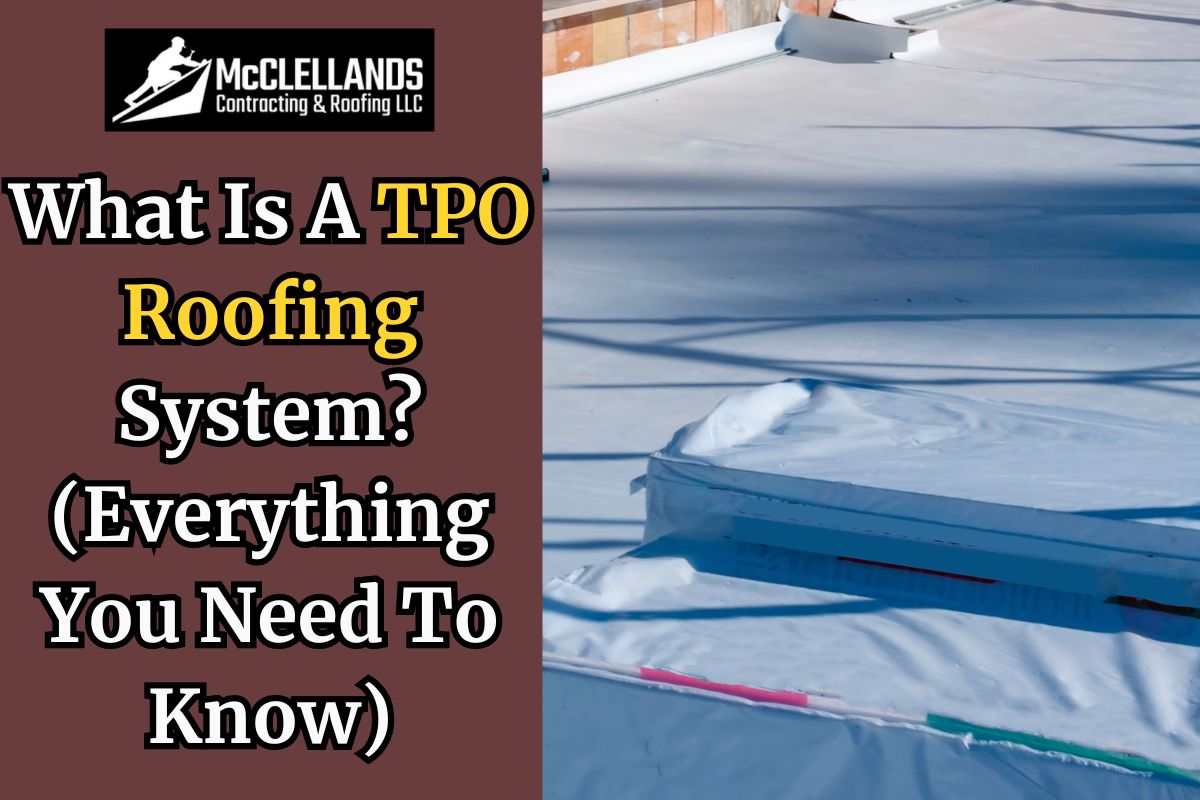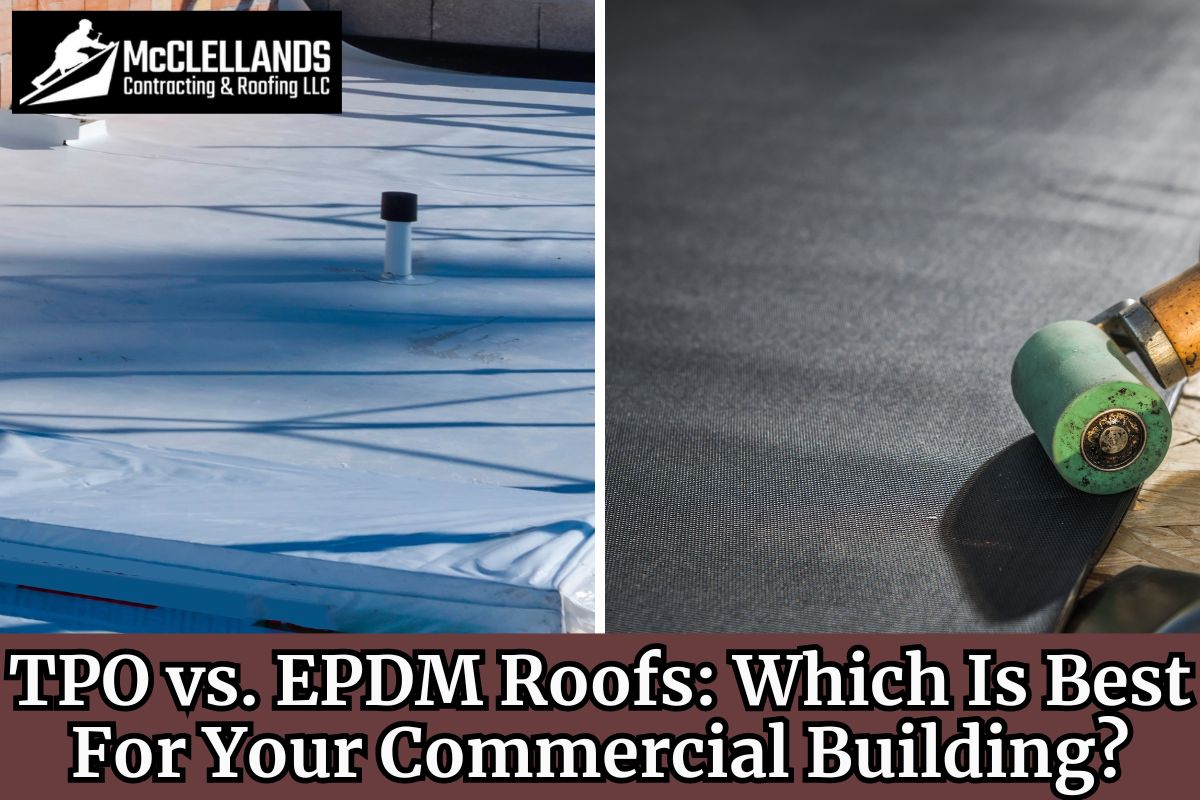If your commercial building’s roof is aging and needs to be replaced, consider a TPO roof. It’s a modern, cost-effective solution with two main benefits. First, TPO protects your building from rain, wind, and harsh sun, preventing weather damage and ensuring smooth business operations. It also saves energy by reflecting the sun’s rays, keeping your building cooler in summer and reducing cooling costs.
At McClellands Contracting and Roofing, we guide business owners through roofing projects, including new roof installations. In this blog post, we’ll cover what TPO roofs are made of, their costs, types, pros, and cons. Stay tuned for more details!
What Is TPO Made Of?
TPO, also known as thermoplastic polyolefin, is a single-ply membrane roofing system. It is made of a few main parts. The primary material is thermoplastic polyolefin, a type of plastic that is extremely durable, making it a good choice for roofs.
Another important layer is the polyester-reinforced scrim. This TPO roofing material makes the roof strong. It helps prevent punctures and damage, even when it's windy or people walk on the roof.
The main role of TPO is to keep your building dry and cool. It also reflects sunlight, which helps keep your building cooler in summer, saving you money on air conditioning.
TPO membranes are generally available in large sheets, usually around 10 feet wide. TPO roofs are also easy to install and last a long time. Once installed, they don't need much care, making them a good choice for commercial buildings.
How Long Does A TPO Roof Last?
A TPO roof typically lasts about 25 years. However, how long your TPO roof lasts can depend on a few things. The weather in your area is one factor, extreme heat or cold can affect the roof. How well the roof was installed also matters. A properly installed TPO roof will last longer. Regular maintenance is important, too. Taking care of your roof can help it last the full 25 years or even longer.
The lifespan of your roof also depends on the quality of the TPO roofing material used, as better-quality materials often last longer. The thickness of the TPO membrane also plays a role. Thicker membranes usually last longer than thinner ones.
What Are The Advantages Of A TPO Roof?
TPO roofs are relatively new to the market and are a popular choice for commercial buildings. The pros of TPO roofing membranes justify this increasing popularity. Here, we’ve briefly listed certain upsides of TPO roofs!

#1 They Offer A Waterproof Surface
TPO roofs are excellent at keeping water out. They create a tough barrier that prevents water from seeping into your building’s roof. This protects the property from leaks, water damage, and associated problems like rot or mold.
#2 TPO Roofs Are Durable
TPO roofing membranes are very strong. They can easily support the weight of rooftop machinery and foot traffic. They also don't puncture easily, and small rocks, branches, or other debris are less likely to cause harm.
#3 TPO Roofs Are An Energy-Efficient Choice
TPO roofs are a type of cool roof. They reflect sunlight instead of absorbing it, making them ideal for areas with hot climates.
What Are The Disadvantages Of A TPO Roof?
Like all other roofing systems, TPO roofs also have certain limitations. Let’s look at some of them.
#1 Leakage & Seam Problems
TPO roofs are made of big sheets that are joined together. These seams can be weak points and might leak or get damaged over time. You need to check the seams often to make sure they're still keeping water out. Even if the roof is properly installed, you still need to take care of the seams.
#2 They May Face Issues In Winters
TPO roofs are great for hot weather because they reflect sunlight, but this can be a problem in winter. Because they don't absorb heat well, your building might be colder in winter.
How To Install A TPO Roof
Some steps need to be followed accurately to install a TPO roof. Here, we’ve written out an overview of the steps to provide you with an idea of how TPO roofs are installed!
Step 1. Remove the old roofing materials and clean the roof deck.
Step 2. Roll out the TPO roofing membrane over the roof deck.
Step 3. Secure the TPO membrane to the roof. This is done with adhesives or fasteners.
Step 4. Use a hot air gun or welding machine to seal the seams of the TPO material.
Can It Be A DIY Project?
These steps might sound simple, but TPO roofing installation is not a DIY project. It needs professional skills and tools. Here's why:
TPO is tough but needs careful handling. Small mistakes can cause big problems later. Professionals know how to handle the material and ensure it is properly sealed.
Also, working on a roof is risky and dangerous. Professionals have safety equipment and follow guidelines to ensure workers’ well-being.
Consider hiring an expert not only for a full roof replacement or installation but also for TPO roof repairs. Professionals understand TPO membrane roofing systems and can fix issues properly and efficiently.
How Much Does A TPO Roofing System Cost?
On average, you can expect to pay between $7 and $15 per square foot for a TPO membrane roof. This price usually includes both the materials and the installation.
The final cost of your project can change based on a few things. The size of your roof is a big factor. As larger roofs need more material and take longer to install, this will affect your overall cost.
The shape of your roof matters, too. If your roof has a lot of angles, vents, or rooftop equipment, it might cost more.
The thickness of the TPO membrane you choose can also affect the price. Thicker membranes tend to cost more, but comparatively, they last longer.
Where you live can impact the cost as well, as labor prices vary in different areas.
Remember, the quality of the material you choose will determine the longevity of your roofing system. If you want a durable roofing system that can protect your building for a long time, consider spending on high-quality materials and installation.
3 Best Rated TPO Membrane Manufacturers
Here are three of the most trusted TPO membrane manufacturers!
GAF
GAF is a major roofing material manufacturer in North America. They make many types of roofs for homes and businesses, including asphalt shingles and TPO and PVC membranes. Their EverGuard® TPO roofing membranes are strong, energy-efficient, and easy to install. They're environmentally friendly, too, as they reflect UV rays and can lower cooling costs for businesses.
Carlisle SynTec System
This company has been manufacturing single-ply roof membranes since the 1960s and offers Sure-Weld® TPO as a durable, premium flat roof material. These roofs can save energy by keeping buildings cool. Carlisle has a commitment to sustainability and tries to manufacture roofs in ways that don't hurt the Earth.
Johns Manville
Johns Manville produces a variety of building components, including TPO roofs. Their roofs last a long time, save energy, and are easy to install. Like the others, these roofs are good at keeping buildings cool. Their rolls of TPO are larger than competitors, making installation easier and quicker. They also make other kinds of roofs besides TPO.
Call McClellands Contracting And Roofing For Roof Installation In Pittsburgh, PA
Choosing a reliable partner is important for a faultless roof installation. If you are planning a roof installation in Pittsburgh, PA, or the nearby areas, we are here to assist you. We offer installation, full roof replacement, and roof repair services for both residential and commercial properties.
We are among the best-rated roofing and renovation companies in Pennsylvania. Our commitment to quality service sets us apart. We specialize in working with different roofing systems, including TPO roofs, asphalt shingles, EPDM, metal, and more. For more about our services or a custom quote for your project, call us at (412) 353-5660.
Frequently Asked Questions
A. No, TPO roofs are not suitable for high-pitched or sloped roofs. TPO roofs are best suited for flat and low-sloped roofs because of their installation process. The membrane needs a flat surface to ensure the seams are properly sealed.
A. Yes. You can pressure wash a TPO roof with a low-pressure power washer with 2,000 psi. However, it’s a good idea to call a professional to pressure wash your TPO roof to avoid any chance of damage to the membrane.
A. Coatings like acrylic and silicone are generally considered best for TPO roofs.
A. There are two options for sealing the TPO roofs. They can be sealed with adhesives or they can be mechanically fastened. No matter which way, they must be sealed really well, especially around the edges, to ensure flawless functionality.



